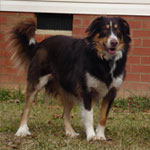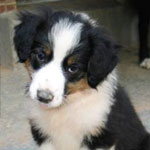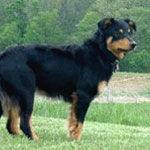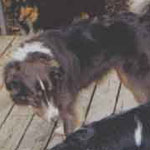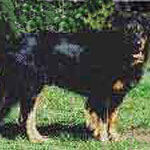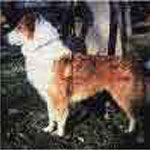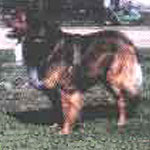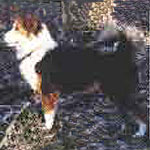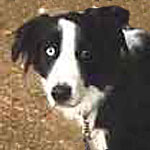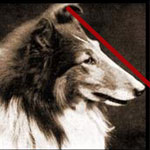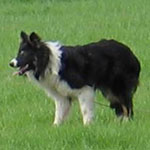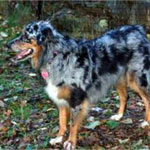|
All the dogs here are English shepherds (not mixes or unknowns) that were fostered, rehabbed, and re-homed by National English Shepherd Rescue.
Stop
|
Narrower type of head/muzzle with shallow stop; AKC-type collie often has no stop, (represented by red line.) Also note larger eyes. |
|
Ear Set
|
Ears may also be dropped like these. Registered black & white young male ES - NC dog pound. |
|
Ears up with excitement. Black and Tan young male ES - WI owner surrender. |
|
Common ear set but there is much variation. Poor coat from malnutrition; bitches may molt & look scraggly. Black & tan w/ white male ES — rural OH dog pound. |
|
Coloring
Coat color is one of the most obvious and therefore most confusing things when trying to determine if a dog is a Border Collie or an Australian Shepherd or an English Shepherd.
Traditionally, when people see a black and white herding dog they think "oh, look, a Border Collie" while a blue merle dog is identified as an Australian Shepherd and a black and tan dog is either an English Shepherd or some sort of collie dog cross.
But it's not that easy. These breeds are all closely related and there is no color for one breed that can not show up in the other two. And, because crosses are not only possible but common it's pretty much impossible to identify a dog based on color. But, with that said, here are brief descriptions of the colour differences between these dogs
Border Collies - Most often black with white collie markings of collar, blaze, socks & tip of tail; very rarely without any white; can be all white w/black ears, eye patches, or other black markings. Many are tri-colored, that is, black & white with varying amounts of tan. Can be red, blue (grey), blue or red merle, brindle, or sable, all with varying amounts of white, and sometimes tan as well
Australian Shepherd - The recognized colors are blue merle, red (liver) merle, solid black and solid red (liver) all with or without white markings and/or tan (copper) points. There are other colors which crop up, these include sable, brown merles, brindle, gray/slate, diluted red, and blond. All white, or mostly white Aussies are uncommon, because of genetic health problems, but not unheard of.
English Shepherd - English Shepherds come in black and white, black and tan, and sable and white - in all three combos the first color is the primary one and the second color can range from almost non-existant to covering a third of the dog. They also come as tri-colors which which can range from a little white on a black and tan to white feet, ruffs, and blazes. Tri-colors can also appear as sables with black shadings or to black saddles.
The English shepherd bitch below and adolescent male are sable and white. Sable can range from pale yellow to dark brown, with or without a black overlay, a black mask, or a black saddle on the back. There are solid sable ES. These dogs are often classed as “collies” by shelters. Note this dog’s broad skull, rose ears, and blunt muzzle, as well as her moderate coat.
|
Young English Shepherd with Sable & White (called Milk Sable or Clear Sable) Coloring. |
|
Male Shaded Sable & White. |
|
Black Mask. |
|
Female Tri- coloring |
|
Tricolor ES pup, @ 10 wks, litter surrendered to Rescue, very typical appearance. |
|
Black and Tan English Shepherd. |
|
Black and White English Shepherd. |
Not all ES are “classically” marked. There are dogs with more white, like the bitch below, and even some “piebald” ES. Solid sable and solid black dogs also occur, but are uncommon. Dark and light liver colored English Shepherds exist as well. Don’t get too hung up on color when deciding whether a dog might be an English shepherd.
|
English Shepherd with more white. |
|
Grey tri color. |
|
Body Type
The terms square and rectangular may be a bit confusing. All three of these breeds are bred for working and none could be considered "dainty". Aussies tend to give more of an appearance of stockiness though. I describe them as "square" because their height to length ratio is closer to 1:1 than BCs and ES who both tend to be longer than tall.
Both BCs and ES tend to be "leggier" than Aussies although some of that is an optical illusion because the heavy Aussie coat can obscure the legs a bit. Young dogs of all three breeds tend to be leaner so knowing the age will help determine if a dog is in that awkward teenage stage or is really that lean and lanky.
|
Heavier Build |
|
Leaner Build. |
|
This dog has typical proportions, but his tail is shorter than. Often light leg feathers, heavy butt and tail feathers. Heavy neck ruff — more common in males. |
|
Malnourished black & tan female ES, @ 1/2 normal body weight at 7 months - OH pound.
|
|
Coat
Coats are another confusing issues. Many dogs don't really come in to their coat until they are adults. Knowing the approximate age of the dog will help here.
Aussies bred for conformation tend to have very heavy coats while working aussies have a lot less. Dogs in the south often have less coat than northern dogs and of course winter coats are heavier than summer ones. Show Aussies will have the densest, longest coats and smooth dogs are nearly unheard of (but not impossible) in English Shepherds and Aussies - but after that really all bets are off and each of the breeds could trade fur suits with the other and no one would know better. |
Tails
English Shepherds can also be born with a natural bob tail.
|
Standard Tail |
|
"Sabre" Tail |
|
"Gay" Tail |
|
"Bob" Tail |
|
Eye Color
|
English Shepherds usually have brown eyes but blue eyes (either one or both) can happen with any color ES. |
|
Working Style
The easiest way to tell a Border Collie from an Australian Shepherd from an English Shepherd is to work some stock with them. Even dogs who have never seen livestock will probably react the way typical of their breed. That's how these breeds have evolved over the last 100 years and it's the best determining factor there is. If you get to use this part of the chart count the information gathered here as double or even triple the value of the other factors.
Shelters don't have a spare flock of sheep around, though, and most people with livestock are not going to be very keen about strange dogs getting a chance to chase the stock around the field. So unfortunatly this is not an easy way to test for breed.
But, on the rare occasion it is possible, this will pretty concretely determine the dog's breed. This is what these dogs were bred for and it is the one thing each breed does distinctly (and well)."Heading" and "Heeling" - One pair of terms we have listed is "header" and "heeler". All three breeds are quite capable of doing both. A "header" is a dog that goes to the head of the stock and turns them that way, they don't so much drive stock as steer it. This is the typical BC approach and works best on sheep. Some Aussies are natural "headers", too. A "heeler" on the other hand gets behind the stock and drives it to the destination, often nipping at heels to keep the stock moving. This is most helpful moving cattle. Aussies and English Shepherds tend more toward this approach. |
Breeds Confused with the English Shepherd
Breed Comparison Chart
(Compare the English Shepherd, Border Collie and Australian Shepherd)
|
This is an AKC-type collie head. Note the straight skull—no stop or cranial vault—and tiny eyes. Not an ES. |
|
This is an Old English sheepdog. Some people get confused about the two breeds because the names are similar. Not an ES. |
|
This dog is a border collie. It can be impossible to tell an ES from a BC by appearance. Many ES look just like this dog. But he is “eyeing” livestock here — this intense stare is a BC trait, and is uncommon in ES. Not an ES. |
|
This distinctive gray/black or red/cream mottling is called “merle.” A dog with any merling is not an English shepherd. If it otherwise resembles an ES, it may be a border collie, but is probably an Australian shepherd like this dog, especially if it has a bobbed tail. |
|
|
|
Stop
Ear Set
Coloring
Body Type
Coat
Tails
Eye Color
Working Style
Breeds Confused with the English Shepherd
The dog may be an English shepherd if:
- The dog was identified as an ES by an owner
- The dog is identified as a “farm collie” by a previous owner
- The dog is not identified by a previous owner as an Australian shepherd, border collie, AKC collie, or mix of the above
- The dog resembles the dogs shown here, and/or at www.englishshepherd.org, and it does not have features listed at right as absent in the ES breed.
- The dog came from an area with many small farms and a known population of ES.
The dog is probably not an English shepherd if:
- It is less than 30 pounds or more than 90 pounds (healthy adult weight—adjust for pups, thin and overweight dogs)
- It has houndy, very droopy ears, or two completely pricked ears when relaxed
- It shows very strong eye when stalking “prey,” possibly including toys. (It is probably a border collie if it does this.)
- It is a color not illustrated or described on this sheet, such as brindle, white, solid gray
- It is an owner turn-in and the owner stated it is another breed.
- It came from an urban area with many mixed-breed dogs that could resemble ES.
The dog is not an English shepherd if:
- It is red or blue merle colored (like many Australian shepherds and some collies)
- It has a short coat (like a German shepherd or shorter) — note that puppies will sometimes seem to have a short coat
- It has long hair growing on the face (like an Old English sheepdog)
- It has very short legs (like a corgi)
- It has hanging flews or lots of loose skin (like a bloodhound)
- It has a pushed-in nose or other dwarf features (like a bulldog)
- It has a very long narrow “needle” nose and small eyes (like a show collie)
|
|










